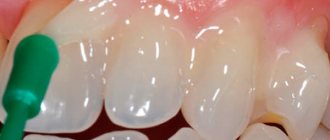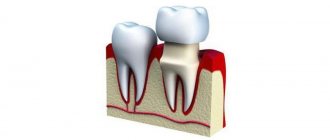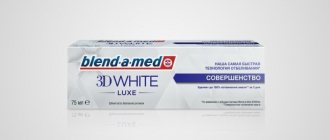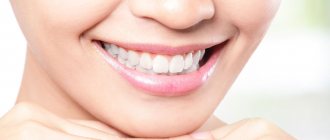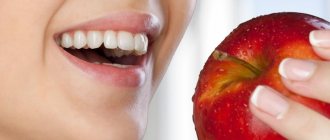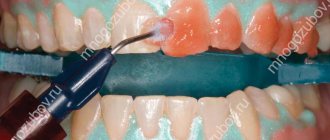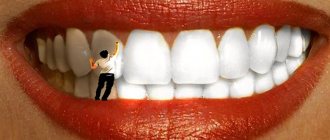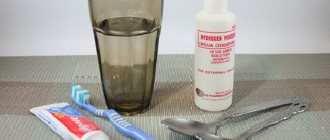4627
Whitening teeth in a dental clinic is a very expensive procedure, and home whitening methods often involve the use of aggressive substances.
Now a new method of lightening enamel has appeared that does not damage the surface of crowns and is affordable - dental varnish.
What is dental fluoridation?
Fluoridation of teeth is an effective method of strengthening tooth enamel and protecting teeth from caries.
A deficiency of fluoride and calcium in the human body inevitably leads to the destruction of dentin (the main part of the tooth) and the enamel covering it. The result is increased tooth sensitivity, a tendency to develop caries, and periodontal disease.
Fluoridation is a painless and absolutely safe procedure, the essence of which is to apply a thin layer of fluoride-containing compounds (fluorides) to the surface of the teeth.
After fluoridation, it is recommended not to eat for several hours (4-6 depending on the drugs used), and also not to drink too hot or, conversely, cold drinks. In addition, you should refrain from eating solid food for 24 hours. These recommendations are due to the possibility of damaging the protective layer of fluoride applied to the teeth. If deep fluoridation has been carried out, you can eat and drink immediately.
Fluoride varnish
The composition of the varnish, which protects tooth enamel and prevents calcium leaching, includes:
- sodium fluoride;
- shellac;
- fir balsam;
- chloroform;
- ethyl alcohol, etc.
All these substances act in synergy - they provide high-quality disinfection of the treated surface and effectively strengthen it. When enamel comes into contact with sodium fluoride, a hard protective layer is formed. It is thanks to him that the unit ceases to be overly sensitive to salty, spicy and sour foods, and temperature changes.
The mixture has a positive effect on the condition of the gums. After its use, soft tissues become less inflamed and bleed less.
Why coat your teeth with fluoride?
So what does fluoridation do? This method can be used by both adults and children to strengthen enamel and improve its strength properties.
Fluoride is an important element that not only makes enamel stronger, but also prevents the rapid proliferation of bacteria. Among other things, the resistance of teeth to an acidic environment increases, which means their surface becomes less susceptible to various types of destructive substances.
The fluoridation procedure must be repeated annually - then the teeth will be reliably protected from caries and not subject to premature destruction; The gradual leaching of calcium will stop, making the enamel stronger.
What it is?
The main role of whitening varnish is to temporarily mask the pigmented surface of the crowns.
Many people compare the functions of this product with foundation. It is also applied to the enamel, covering it with a glossy layer, the color of which is several times whiter than the crowns.
Unlike other lightening agents, varnish allows you to even out the color even in filled teeth. The product is easy to use and does not require special preparation of crowns.
The main components in them are :
- protective film-forming agent;
- titanium dioxide , which performs a coloring function;
- mineral and fluoride additives , such as hydroxyapatite and fluorides.
The use of varnish is recommended to strengthen the enamel in case of poor quality, pigmentation and uneven surfaces (cracks, small chips).
It is common to use the product for photo and video filming or important life events, since the corrector makes it possible to obtain instant results.
Manufacturers often guarantee that the layer will remain intact for 12-24 hours, but often its integrity is compromised within 4 hours of application.
Types of fluoridation
Currently, fluoridation of teeth is carried out using two methods - simple and deep:
- Simple fluoridation . To carry out the procedure, special “spoons” are used that look like mouth guards, which are filled with a fluoride-containing composition and placed on the jaw for 10-15 minutes. To complete the full course, you need to conduct at least 10 sessions. An alternative option is simple fluoridation using a fluoride-containing varnish. It is applied with a special brush to the surface of the teeth and allowed to dry. The full course consists of 3-4 procedures, depending on the individual characteristics of the body and the drug used.
- Deep fluoridation . The main difference between this method and the previous one is the use of special enamel-sealing preparations. In addition, deep fluoridation requires careful preparation of teeth, therefore it is carried out exclusively in professional clinics. After the stage of cleaning the teeth, a special composition is applied to their surface using a tampon for 1-2 minutes, after which it is dried under the pressure of warm air. Then the surface of the teeth is stained with a swab dipped in calcium copper hydroxide milk, and then rinsed with clean warm water. The advantage of deep fluoridation is that the solution penetrates into the deep layers of enamel, making teeth much stronger. According to dentists, the effectiveness of deep fluoridation is 5 times higher than that of simple fluoridation.
How to use
Instructions for applying teeth whitening varnish
- The varnish should not be applied to the damp surface of the teeth, as it will not adhere to the enamel. Before applying the varnish, you need to clean and dry the surface with a napkin or cotton pad.
- Some manufacturers add a retractor to their whitening kit. If available, place it in the mouth.
- Shake the bottle before use.
- The varnish is applied in a thin layer to the surface of the tooth in the direction from the gums to the cutting edge.
- Wait the recommended time for the polish to dry without covering your mouth. If necessary, apply a second coat of varnish until the enamel is completely covered.
Teeth whitening varnish can be treated at least every day.
Algorithm for applying fluoride varnish
- The working field is isolated from the adjacent surfaces of the lips.
- The surface of the teeth is dried with a cotton swab.
- The doctor coats the teeth front and back with fluoride varnish using a special brush or applicator. The number of applications is determined by the dentist.
- The patient needs to sit with his mouth open for 5 minutes to fix the composition.
It is recommended to carry out fluoridation in the dentist's office 2 times a year.
Benefit
As already mentioned, the main goal of fluoridation is to strengthen tooth enamel. In addition, there are other advantages of this procedure:
- The sensitivity of the teeth is reduced, so there is no discomfort when consuming cold and hot food or drinks.
- The risk of developing caries is reduced due to a reduction in the number of pathogenic bacteria and increased resistance of teeth to an acidic environment.
- Fluoridation prevents calcium from being washed out of tooth enamel, making teeth stronger and stronger.
Does fluoride varnish whiten teeth?
Will there be a whitening effect? Some patients also ask this question, especially when they see photos on the Internet before and after a procedure performed in a dental office. And here it is important to note that the product itself does not have a whitening effect. However, before applying it, the doctor, as we said above, carries out professional hygiene, during which dirt, pigment and plaque are removed. Therefore, after it, the enamel really becomes cleaner and even lighter by several shades, it acquires its natural color. And the coating applied to it as a result visually makes it even smoother and gives it a healthy shine.
Harm
As you know, you need to know moderation in everything. Those who like to experiment with various fluoride-containing drugs need to know the following:
- Fluorides are toxic substances that in large quantities can cause serious harm to the human body. Therefore, if you prefer to use toothpastes with fluoride, then it is better to refrain from the fluoridation procedure. And vice versa - if you have coated your tooth enamel with fluoride, then you should choose toothpastes that do not contain this chemical element.
- Fluorosis is an excessive accumulation of fluoride in the body. Fluorosis leads to brittle bones, anemia, and neuralgic abnormalities. As for teeth, when fluoride accumulates excessively in them, the enamel begins to rapidly deteriorate, which invariably affects their appearance.
Is it possible to carry out the procedure at home?
Some people (usually in order to save money) are interested in whether they can do this procedure themselves. Moreover, the product can be easily purchased at the pharmacy. Doctors answer unequivocally - you shouldn’t do this. And many manufacturers state in the instructions that the drug cannot be used at home.
It seems that covering your teeth with fluoride varnish is simple - just “scoop” a little of the composition from the bottle with a brush and carefully apply it to each tooth. However, in reality this is not the case. There are several very important points here.
The first nuance is that before the procedure you need to clean the enamel of contaminants. Because it is simply pointless to apply a protective layer to soft and hard bacterial plaque. You're not going to protect bacteria, are you? Without hygienic cleaning by a dentist, this measure will be ineffective.
The second nuance is that the product is thick, and to achieve a positive effect and for safety reasons, it must be applied in a thin layer and evenly, without touching the gums, tongue and mucous membranes. It is quite difficult to do all this at home: there is always a risk of overdoing the dosage, as well as injuring or burning the mucous membrane.
The third nuance is that people who apply fluoride at home often neglect the fact that its use in large quantities and too often can be dangerous for the body, as well as for the enamel itself. Fluorine tends to accumulate in bone structures and tissues, and due to excess it becomes toxic, which leads to unpleasant consequences. You may experience fluorosis, increased fragility and brittleness of the enamel.
Important! If you bought fluoride dental varnish for home use, you need to know how to use it correctly. Make sure that you have no contraindications and do not suffer from an excess of the element (it can be contained in drinking water and toothpaste). Before applying the composition, isolate the gums with cotton sponges. The best time to perform the procedure is before bedtime.
Fluoridation of teeth during pregnancy
During the period of bearing a child, most of all nutrients and minerals from a woman’s body go to the formation of the skeleton and muscle tissue of the unborn baby. Due to calcium deficiency during pregnancy, tooth enamel is destroyed, so fluoridation during this period is very useful. However, before applying fluoride to your teeth, you should have your mouth examined and consult an experienced dentist.
It is important to remember that severe toxicosis is the main contraindication to the procedure, so it is best to plan a trip to the dentist for the 2-3 trimester, when the pregnant woman’s health improves. During breastfeeding, the fluoridation procedure will also not be superfluous.
How often can you do it
Uncontrolled use and ignorance of how to use the drug will lead to oversaturation of the enamel with fluoride. To prevent this, remember that the optimal number of times a year when a potent product can be applied to your teeth is twice. According to the testimony of a specialist, and only if carried out in a dental office - up to 3-4 times a year.
Experts recommend carrying out the procedure every 3-6 months also because the protective properties of the drug are preserved for about that long.
Contraindications and indications
To the question “When should you resort to dental fluoridation?” there is no clear answer. Dentists suggest performing it for children and adults as a preventive measure for caries, but there are other indications for coating teeth with fluoride-containing compounds:
- Increased sensitivity. As a rule, it manifests itself in the form of discomfort when eating cold foods or drinks, fresh fruits or vegetables. Fluoridation helps strengthen the enamel, thereby reducing dentin sensitivity.
- Tendency to develop caries. If you often visit dentists for dental treatment, then fluoridation is an excellent way to extend the life of your fillings and also prevent the formation of new enamel damage.
- Recent gum disease.
- Accumulation of a large amount of yellow plaque at the base of the tooth (above the gum).
- The fluoridation procedure is also carried out after removing braces.
- For children 6 years of age and older, fluoridation is recommended to prevent tooth decay and to maintain overall dental health.
Contraindications include only individual intolerance to certain elements of fluorine-containing formulations, as well as an excess of fluoride in the body. If the patient lives in an area where the fluoride content in the water is quite high, in this case the doctor will most likely offer you other preventative procedures to protect and strengthen the enamel.
Types of dental varnishes for teeth
Whitening cosmetic varnishes
Professional whitening, which is offered by dental clinics, has one drawback - high cost. But there are options on how to achieve the effect of a “Hollywood” smile at minimal cost. Teeth enamel whitening varnish will help with this.
It makes teeth white from the first application, brightening them by at least 10 shades and giving a glossy shine. Products from different manufacturers may differ in the degree of whiteness and duration of action, but on average, one coat of teeth with varnish is enough for a maximum of a day. The principle of action is similar to nail polishes: the teeth are temporarily stained and, as a result, become whiter.
After the composition dries, a white film coating forms on the teeth, which can be easily removed with a toothbrush if desired, but can also be easily removed along with solid foods and drinks. The effect of whitening varnish-paint does not affect your own enamel; it will not relieve tooth sensitivity, if any.
The coating can be applied to restorations: on fillings, veneers, and crowns, it will have the same properties as on regular teeth.
The composition of different teeth whitening varnishes may vary, but some components are present in all products:
- film former;
- coloring component.
With repeated use, such varnishes can lighten your own tooth enamel by several tones. Manufacturers assure that, in addition to coloring, such varnishes have a remineralizing effect due to a special additive (hydroxyapatite), that is, they help restore and strengthen tooth enamel. In addition, the film has antiseptic and bactericidal properties, thus, while present on the teeth, it protects them from caries.
Main indications for the use of whitening varnish:
- pigment spots on enamel;
- darkening of enamel from tobacco, coloring foods and drinks;
- difference in color of fillings and crowns.
Teeth whitening varnishes are good as a temporary solution, for example, for photo shoots, special events or public appearances when you need to look perfect. Safety: whitening varnishes do not contain acetone and other chemically hazardous components, therefore they do not damage tooth enamel and mucous membranes, and do not cause discomfort during application and presence in the mouth.
Note that whitening varnishes are not effective for problems such as moderate and severe forms of fluorosis, enamel hypoplasia, severe chips: in this case, tooth defects cannot be masked with several layers of varnish. With such defects, only ceramic restoration can improve the aesthetics.
Fluoride varnishes
Fluoridation is a procedure that is performed in a dental office. Goes in combination with professional oral hygiene.
When areas of enamel demineralization appear on a tooth, it becomes sensitive: it reacts to cold, hot, acidic foods and drinks. Dentists use fluoride preparations that seal open dentinal tubules, eliminating increased sensitivity.
Problems that fluoride varnish solves:
- decreased enamel sensitivity;
- prevention of caries;
- preventing further development of caries when it is at the spot stage.
Unlike whitening varnishes, fluoride varnishes are absolutely transparent on the teeth and do not have a whitening effect, but due to the preliminary removal of soft and hard plaque from the teeth during professional hygiene, the enamel is slightly lightened. Fluoride varnish creates a colorless protective film on the tooth surface that prevents the harmful effects of bacteria.
Fluoride-containing preparations are not applied to crowns, veneers, or dentures. It is recommended to begin fluoridation procedures in childhood, from the moment the baby teeth erupt, as this will protect the rudiments of permanent teeth. Fluoridation is also carried out for pregnant women, since the drugs are safe and do not have a negative impact on the health of a woman expecting the birth of a child. Fluoridation is especially recommended after removal of braces and clinical whitening.
The composition of fluoride varnish includes:
- sodium fluoride;
- chloroform;
- shellac;
- ethanol;
- fir resin.
Many have heard about the dangers of fluoride, and we have already talked about the consequences of its excess in the body. Dentists agree that the use of toothpastes with fluoride at a certain concentration of this element has a bad effect on tooth enamel and on health in general, especially if there is an increased content of fluoride in drinking water in a given region. But the concentration of fluorides in fluoride varnish is very small and cannot harm dental health. Therefore, fluoridation is recommended for the population even in regions with high fluoride content in water.
Remineralizing varnishes for children
Children's dental varnishes for remineralization can be distinguished into a separate category. Varnishes for children's teeth are available in various flavors, so that the little patient has a pleasant impression of visiting the doctor, and he does not feel afraid of the necessary medical procedures. The products contain xelitol, which allows you to fight pathogenic bacteria in the oral cavity some time after application.
Stages of the procedure
Regardless of the chosen fluoridation method, this procedure includes the following steps:
- Oral hygiene. This can be either a full professional cleaning (removal of plaque and tartar), or a simple treatment with antiseptic dental compounds. The tooth surface must be clean before applying fluoride-containing compounds so that the mineral substances can protect the enamel.
- Thorough drying with warm air.
- Depending on the chosen method of fluoridation, either fluoride-containing varnish is applied to the teeth, or a mouth guard with a special paste is put on for 10-15 minutes.
- During deep fluoridation, the surface of the teeth is covered with an enamel-sealing liquid, which is thoroughly dried and carefully shaded. After 1-2 minutes, rinse the oral cavity.
It is also important to understand that fluoridation is advisable only on healthy teeth, so before the procedure it is imperative to sanitize the oral cavity.
Prof. hygiene with 20% discount
Moscow
What's on sale?
The range of varnishes is distinguished by a wide range. Among them, each user can find products that suit exactly his requirements. Let's look at some of the most popular options at the moment.
Dental Paint
This product is designed to lighten your skin by 15 shades in just a couple of minutes. With daily use, the bottle is enough for at least 40 applications.
The varnish contains an antibacterial and remineralizing complex , which, with regular use, allows you to lighten the inner layers of enamel by 2-3 tones.
The coloring composition used is food pigment and an alcohol-based solvent.
This drug is recommended for use by people with highly sensitive teeth.
Its cost on average is 2000 rubles.
White Enamel
A Russian-made corrector containing a combination of mineral and antibacterial components. Can be used for both temporary and permanent lightening.
As a result of regular use, the upper layers of the tooth acquire a shade 4 times lighter than the original one . When applied, the color of the crowns becomes 6 shades whiter. A 6 ml bottle is enough for daily use for 1.5 months.
The disadvantage of White Enamel is the low strength of the resulting layer, which can be damaged even when eating soft food. The price of this type of varnish is 2300 rubles .
Colordent
The drug is based on a natural film former, which creates a very dense layer of substance that is difficult to damage . In addition, it includes aseptic components that prevent the development of dental diseases.
With this varnish you can whiten crowns by 10 shades. The drying time of the drug is 5 minutes. A small 3 ml bottle is enough for 20 coloring procedures, which is a disadvantage of this product.
The cost of Colordent varnish starts from 1,500 rubles.
Color professional
Just like previous products, this varnish has remineralizing and antibacterial properties. Color professional is recommended for use in cases of “tetracycline” teeth, fluorosis and high enamel sensitivity .
The manufacturer guarantees instant lightening, which takes only 2 minutes. As a result of use, teeth become 10 shades whiter.
The product is designed for 40 applications and, with constant application, allows you to obtain a permanent whitening effect of up to 6 tones.
The cost of varnish ranges from 2000 rubles.
At what age can Lakalut children's toothpaste be used? Recommendations from dentists.
Is teeth whitening with tea tree oil effective? We will tell you here. Tips, photos, descriptions.
At https://www.vash-dentist.ru/krasota-i-uxod/zubnyie-pastyi/rocs-vidyi-opisanie-tsenyi-i-otzyivyi.html we have posted a review of Rox whitening toothpaste.
Liquid porcelain
This type of varnish has a dense consistency, allowing you to create a layer that is well preserved throughout the day . Whitening with it helps to get a shade 10 times whiter than the original one. The layer dries in 3-5 minutes.
A volume of 8 ml is enough for use for 1.5 months. Liquid porcelain has the most affordable price, equal to 650 rubles . But, unfortunately, it is not always possible to find it on pharmacy shelves. In addition, the drug looks unnaturally white on the teeth.
Celebrity white flash
The product from an American company is available in the form of a 3 ml pen bottle, which is enough for only 15 sessions. It is recommended to be used to prolong the effect after professional whitening in a clinic , since it contains a complex of minerals.
Application allows you to whiten crowns by 5 tones or more. Unlike previous types, this varnish has a long drying period: from 5 to 10 minutes. The product is odorless and easy to apply.
The cost of Celebrity white flash is 500 rubles.
Pearl Drops Transform Now…Smile
This corrective drug is placed in a tube that resembles lip gloss. Its characteristic feature is a pleasant aroma that relieves bad breath .
The product is characterized by increased resistance to mechanical damage and allows you to achieve whitening of 5 tones. A 5 ml tube is designed for 3 months of use.
Minimum consumption is achieved due to the liquid consistency of the correction substance.
The product can be purchased at a price of 700 rubles.
Kryolan
A German product, which is classified as a professional cosmetic, used for makeup on actors, for example, to create the effect of a missing tooth.
The corrector is available in several colors at once:
- white;
- Ivory;
- nicotine (brown);
- red;
- black.
The bottle has a volume of 12 ml. The peculiarity of the corrector is that it cannot be used every day and it is contraindicated to eat any food with it . The varnish completely lacks remineralizing and aseptic effect.
Kryolan price – 700 rubles.
Fluoridation of teeth at home
Currently, preparations for fluoridation of teeth can be purchased in pharmacies or specialized clinics. Fluoride varnish is an effective remedy for strengthening teeth at home, but it should be used carefully and only after consultation with your dentist.
In order for fluoridation to bring visible results, it is necessary to take care of the cleanliness of your teeth. Next, you need to strictly follow the instructions included with the drug. Fluoride varnish should be used in courses - 3-4 procedures.
The most common way to strengthen tooth enamel is to use toothpastes containing fluoride. However, it is worth remembering that you cannot use these products for a long time - you need to alternate them from time to time with other drugs that do not contain fluoride.
Content:
- Fluoride varnish
- Why use a fluoride-based protectant?
- Contraindications to the use of fluorine-containing varnishes
- Is it possible to use varnish at home?
- Carrying out the procedure in a dental clinic
- Important nuances
Enamel is the hardest tissue of the human body, but even it becomes thinner over time under the influence of a huge number of different factors.
The procedure of protective coating of teeth with a special varnish allows you to protect the outer shell of the unit and make it more durable. In addition, dental compounds used to treat the teeth of children and adults are a kind of antiseptics. They block the spread of pathogens and thus provide reliable caries prevention.
Most often, when providing a protective coating for teeth, dentists use fluoride varnish. This is a special viscous liquid, including fluorine and other related compounds.
Fluoridation and silvering: what is the difference?
The silvering method is the treatment of teeth with preparations containing silver nitrate. This method of combating caries is prescribed to the youngest children - up to 3 years old. The procedure is quick and painless: saliva is removed from baby teeth, then they are impregnated with a silver preparation. Silvering is used only at the initial stage of caries - “white spots”, and can stop the development of the disease, but does not cure it. In addition, a big disadvantage is the darkening of the teeth as a result of the procedure.
In dentistry, this method is now almost never used, giving way to a more effective fluoridation technique. The procedure is as simple as silvering, but it has advantages over the latter: fluoridation not only prevents the development of caries, but also strengthens tooth enamel.
Expectation and reality: sometimes they don't match
Some people believe that if they coat their teeth with fluoride, they will get rid of tooth decay forever or even cure it this way. However, it is not.
The product will really help stop the process of tissue destruction if you have initial caries in the white spot stage. That is why it is used to treat it. It will also actively fight cariogenic bacteria, preventing the development of this disease. But if there are too many of them, then the protection can be very short-lived.
It is known that teeth begin to decay when the acid-base balance in the mouth decreases, because... It is in an acidic environment that bacteria are most active and productive. In fact, if you eat a lot of carbohydrates and sweets, the sugars from which bacteria feed, then tooth decay will sooner or later appear again. If you want fluoride varnish to last as long as possible and your teeth to remain strong, then adjust your daily diet.
There are also people with increased fragility and fragility of enamel who, after going through the fluoridation procedure, remain dissatisfied. If the pathology develops against the background of hereditary anomalies, internal diseases of the body, or a sharp change in hormonal levels (for example, during pregnancy), then fluoride varnish alone will not cope with the task. It should be used in combination with other measures: taking vitamins and calcium supplements, reviewing the diet, treating underlying diseases.
Important! Applying fluoride varnish cannot replace dental treatment with a doctor. The product only serves as a preventive measure for dental diseases and increases tissue resistance to bacterial attack, but does not have a pronounced therapeutic effect if the problem already exists.
Tips for strengthening enamel
Taking care of your teeth should include proper nutrition. Without it, preventative medical procedures will be of little benefit. A complete menu to strengthen teeth enamel should include the following foods:
- dairy products: they all contain phosphorus and calcium;
- hard root vegetables - carrots, radishes, apples, cabbage: chewing activates the secretion of saliva, which cleans the crown of the teeth;
- parsley: essential oils of this plant suppress the activity of microorganisms, which affects the cleanliness and safety of teeth and the strength of their coating;
- green tea: tea leaves contain fluoride in their structure, which prevents the formation of plaque and the accumulation of bacteria on the teeth;
- chicken eggs and seafood: they contain iodine, which helps strengthen the enamel.
It is necessary to take care of strengthening teeth from the appearance of the first primary incisor. Those parents who consider their baby’s baby teeth to be temporary and unimportant are deeply mistaken. It is the health of baby teeth that determines the health of future molars.
After six years, a child definitely needs to prevent caries using the drug Fluorlak Omega and other gels/solutions for teeth. Treatment must be prevented by preventing diseases, then dental health will be strong and the enamel will be strong.
Sources used:
- Groshikov M.I. “Non-carious lesions of tooth tissue.” - M.: Medicine, 1985.
- Preventive dentistry / I.K. Lutskaya. - Moscow
- “Pediatric therapeutic dentistry. National leadership" (Leontyev V.K.)
- The European Academy of Pediatric Dentistry (USA)
Indications for use
Many citizens are sure that the most important microelement for teeth is calcium. This is partly true: calcium is responsible for the structural strength of bones. However, fluorine is important for enamel; it is what ensures the strength of its structure. Fluoride is absorbed not only with water and food; this microelement is well absorbed by the enamel from the outside. Therefore, scientists created the drug Fluorlak. Let's consider the question: Fluoride varnish instructions for use.
Enamel protection with a fluoride-containing agent is carried out in dental clinics. However, you can coat your teeth with fluoride varnish yourself. A home procedure will be much cheaper and will save time. Who is the fluoridation procedure indicated for? A lack of fluoride in drinking water provokes massive caries disease, so fluoridation is primarily indicated for people living in the area. The use of the drug is also indicated:
- people with high enamel permeability;
- pregnant and elderly people;
- children over six years of age living in areas with low fluoride content in water;
- with mechanical destruction of enamel: chips, cracks;
- before placing dentures (after grinding the crown);
- after ultrasonic cleansing;
- with a wedge-shaped defect.
A contraindication to fluoridation is an excess of fluoride in bone tissue (fluorosis) and sensitivity to the components of the drug.
Fluoridation in the doctor's office
How does the fluoride varnish treatment process work? The dentist uses a special brush or roller for this. Before the procedure begins, the crowns of the teeth are treated: plaque is removed, and any hard formations are removed. Then salivation is eliminated and the surface of the teeth is dried.
The coating begins with the lower jaw, after which it moves to the upper dentition. When the treatment is completed, the patient remains with his mouth open for some time until the composition dries completely. After fluoridation, you should not brush your teeth or eat hard foods for a day, so as not to damage the fresh layer of varnish. Since it is impossible to apply a thick layer of fluoride in one procedure, fluoridation is carried out several times at intervals of 3-4 days.
How long will fluoride varnish last in dentistry? Typically, the protective film lasts for six months, so after this period of time the procedure should be repeated. Does this product change the color of the enamel? No, a similar effect was not noticed after using Fluoride Lac.
Fluoride varnish for teeth at home
How to apply fluoride varnish for teeth at home? Coating teeth with the composition is not difficult, however, buying the drug is quite problematic: it cannot be found in pharmacies. To purchase this product (Fluorolak Omega), you must place an order in stores specializing in the sale of dental products.
How to apply fluoride varnish instructions:
- Clean your mouth with paste.
- Dry the surface of the teeth: to do this, wipe the crowns with a cotton swab or place gauze pads between the lips/cheek and isolate the teeth from saliva.
- Soak a cotton swab in the solution and rub the enamel (it is better to start treating the crowns of the bottom row).
- Keep your mouth open until the mixture dries (takes about five minutes).
Important! After treating enamel with fluorine-containing varnish, you should not eat for 12 hours, so it is advisable to carry out the procedure in the evening. The sooner the food touches the coating, the less time it will last.
What difficulties may arise during the home fluoridation procedure? Do not allow the composition to come into contact with the mucous membrane. It is necessary to carefully monitor the application of fluoride varnish to the teeth. If the product gets on the mucous membrane, it can cause negative consequences - a burn.
What is fluoride varnish?
Fluoride varnish is a specialized product. It is used in dental clinics for therapeutic and preventive purposes. However, it can be purchased at some pharmacies. The active ingredient in fluoride varnish is sodium fluoride, NaF. Recently, conventional fluoride varnish has been replaced by products created on the basis of aminofluoride. This is a new product that is included in the products of some oral care companies. They contain additional components: shellac, ethyl alcohol, pine extract.
Fluoride varnish is produced in dark glass bottles with a capacity of up to 30 ml. It is a dark thick liquid. The kit is equipped with a brush or other tool for applying to teeth.
Should baby teeth be fluoridated?
Many parents do not pay due attention to their child’s baby teeth: they will fall out anyway. Such frivolity can lead to damage to the rudiments of molar permanent teeth. Fluoridation remineralizes the enamel and saturates it with fluoride-containing microelements. This provides:
- resistance of baby teeth to decay;
- reduction of bacterial activity in the oral cavity;
- strengthening the enamel structure.
How is the procedure for protecting baby teeth carried out at the dentist? There are several ways to apply fluoride varnish to baby teeth:
- A simple method: the composition is applied with a brush, then illuminated with a special lamp.
- Deep fluoridation: first, the surface is coated with a composition containing calcium and magnesium salts, then a composition of calcium and copper is applied.
- Express fluoridation: disposable trays with fluoride are used on the teeth.
- Mouthguard fluoridation: a procedure using reusable mouthguards filled with a medicinal composition, which can be performed at home before bed.
- Electrophoresis: remineralization of tooth enamel is carried out using fluoride ions.
If you are prone to caries, the procedure should be repeated every 6 months. If the baby has healthy teeth, prophylaxis is carried out once a year.
Caries prevention can also be carried out using children's gels and special pastes. You should also create a special menu, which should include oats, fish, buckwheat, rice, apples, tea (green and black).
